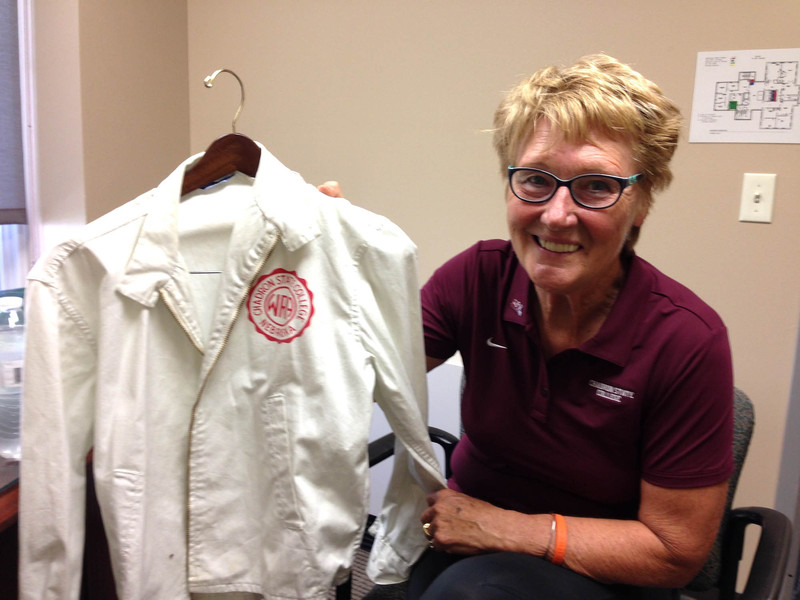Benefits of Title IX extend beyond sports, says CSC graduate

If you want to know how passage of the law prohibiting discrimination in education on the basis of gender has changed the world for women who participate in sports, 1970 Chadron State College graduate JoAnne Owens-Nauslar can give you an insider’s perspective.
And Owens-Nauslar, who as a teacher and education administrator was on the leading edge of women’s entry into competitive sports, can tell you how the benefits of the portion of the 1972 federal education act known as Title IX extend beyond the playing field to many other aspects of women’s lives.
“(Title IX) has a variety of roles it now plays for women in the world,” Owens-Nauslar said. “Acknowledgement, recognition for who they are, the skill they bring and the intellect that can come with the skill level. You can be very smart and very skilled and you can have children. It doesn’t have to be just one thing.”
Now a well-known motivational speaker on health and fitness, Owens-Nauslar got her start in sports young; she was a rodeo bull rider as a teen.
“I was part of what was called the Women’s Recreation Association. I’m pre-Title IX,” she said.
WRA teams traveled to other schools for games, but players had to pay for their own travel expenses, and received little support or recognition.
Following graduation, as a new teacher in her hometown of Newcastle, Wyoming, Owens-Nauslar convinced the school board to create girls teams in volleyball, basketball and track, and coached all three sports. At times, though, her teams had to make do for things that boys athletics took for granted, Owens-Nauslar said.
“We didn’t have uniforms. We put duct tape on our crimson colored shirts,” she said.
And initially, she wasn’t even paid for coaching.
“My second year, they paid me a total of $100 (for coaching),” she said. “At the time men received 10 percent of base salary for head coaching.”
Some of the differences in treatment of women teams may not have been intentional, though, according to Owens-Nauslar.
“I wouldn’t say it was discrimination. It was such a new concept, everybody was like ‘What do we do with this,’” she said.
It’s not hard to show how much Title IX changed things for women’s sports, said Owens-Nauslar.
“(Now) look at the University of Nebraska, where my master’s and doctorate are from, and the last five national championships have been won by women. Here (at CSC) I look at the softball complex and marvel. We played in gravel behind the Armstrong building,” she said. “It obviously has made a difference and we are catching up.”
But those changes didn’t come without considerable effort, according to Owens-Nauslar. She was part of a group of women who traveled frequently to Washington to lobby Congress for gender equity legislation in the wake of the 1964 Civil Rights Act.
“You march on Washington and you get thrown out of really nice places,” she said of the experience.
In 1972 the lobbying effort paid off with the inclusion of an equal education provision, Title IX, in the reauthorization of a 1965 law on higher education. Because of considerable resistance to the effect of the equality rule on men’s college sports, it took three years to formulate rules for implementing Title IX. In the years since Owens-Nauslar said she has seen several efforts to roll back the requirement for “parity and equity” in men’s and women’s sports programs.
“During my 45 year career, we have had to go back to Washington a number of times to continue to defend Title IX,” she said. “About every five to seven years, we are back reminding people that this is not either/or; that everything can coexist and it will be fine.”
The tangible benefits of Title IX for women extend well beyond their college sports careers, according to Owens-Nauslar, who noted that participation in sports teaches valuable lessons about team work, persistence and hard work, and can even be a factor in an employer’s decision about which candidate to hire for a job.
Though she wasn’t a direct beneficiary of the collegiate sports opportunities opened by Title IX, Owens-Nauslar’s career has been focused on health and physical education, the subjects she studied at CSC, and she has been recognized as an advocate for women in sports.
In 2006, the University of Nebraska-Lincoln presented her with a Trailblazer Award for her promotion of health and fitness, and particularly women’s athletics.
“JoAnne is a prime example of outstanding dedication to advancing women’s athletics,” said former UNL Athletic Director Steve Pederson in presenting the award.
Although parity and equity in sports opportunities for men and women is much closer than it was in 1972, there are still gaps, according to Owens-Nauslar. But now the effort for equality has broader support, she said.
“We still have work to do, and men and women … have taken up that cause. This is not female only,” she said.
Women now can take advantage of the changes that have occurred in the last four decades.
“It’s my perception … that if you want to take the bull by the horns, the opportunities are there for females,” Owens-Nauslar said. “You are not entitled to anything. You will work really hard for it, just as any male does. I don’t believe in a sense of entitlement but I do believe in equity and parity. I say to females: ‘Work hard.’”
Category: Campus Announcements, Campus News
